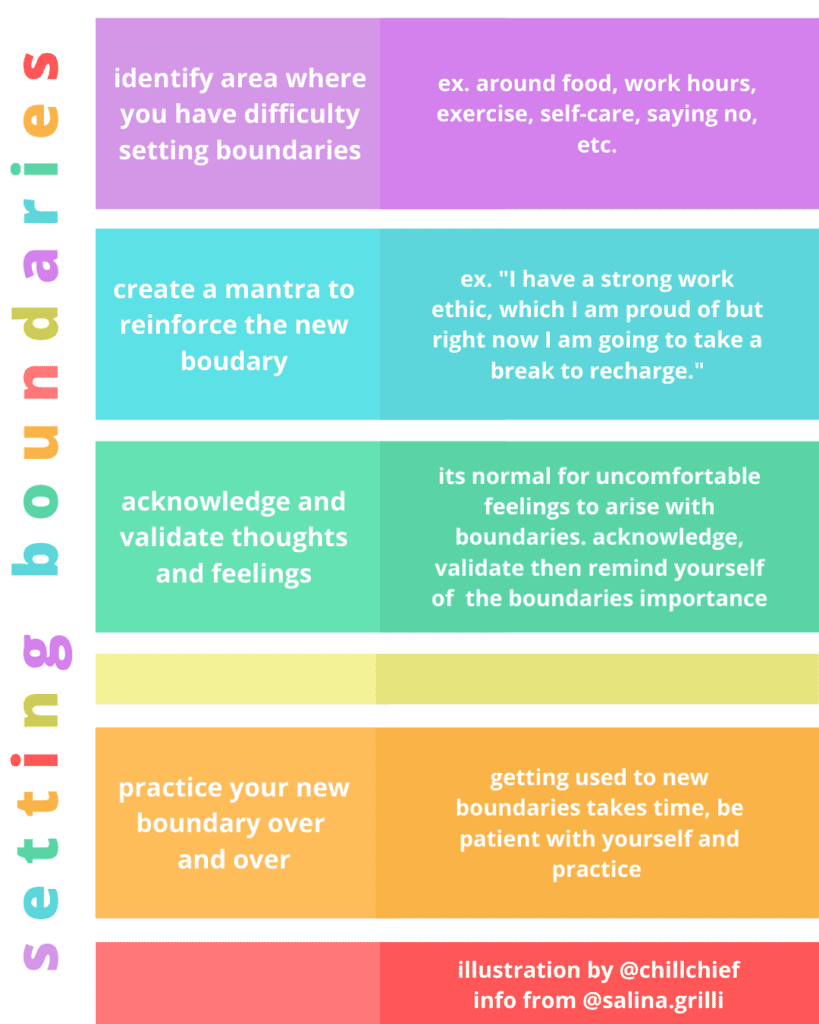The world is demanding and so are the people in it. Without setting healthy boundaries, we can easily become overwhelmed, overcommitted, emotionally drained, or burnt out.
When I was thrust into the adult world after college, “yes” felt like the only appropriate answer to most inquiries about my time and resources. I quickly found myself overcommitted to parties, people, projects, and employers. The candle began burning. In less than 2 years, I felt utterly exhausted and completely confused about who I was or what I wanted.
For years I had spent my time worrying about what others wanted. The sad thing is my story isn’t unique.
Healthy boundaries communicate our limits, dictate what treatment we will tolerate, and affect how we show up in the world. With such impactful effects, it is surprising that many people are unaware of how to set boundaries in their lives.
Salina Grilli is a Licensed Clinical Social Worker. She utilizes a mixture of Cognitive Behavioral Therapy (CBT), Mindfulness and Acceptance and Commitment Therapy (ACT) based techniques to help her clients thrive. You can learn more about Salina by visiting her website or Instagram page.
Today, Salina is using her expertise to answer my questions and guide us on exactly how to identify, set, and maintain healthy boundaries to live more sustainable and fulfilling lives.

What are boundaries and why are boundaries important?
Salina: I often say that “healthy boundaries are the building blocks of self-preservation.”
Essentially boundaries are our personal limits and clearly communicate how we want to be treated. Setting healthy boundaries not only protects our energy and emotional and physical wellbeing, but they also signal to those around us that we expect respect.
Unfortunately, many of us struggle with creating healthy boundaries.
Some of us may have grown up in homes where our boundaries weren’t respected. We learned that we were “good” and “respectful” if we acquiesced to the needs of others. We might have learned to stay quiet when we were uncomfortable because we were shamed when we spoke up about how we felt.
The inability to set or maintain healthy boundaries deeply impacts how we show up in the world. When we don’t enforce our boundaries, we are sending the message to ourselves that our needs and wants are less important. Lack of boundaries leads to feeling emotionally drained and is big contributor to burn out.
When we don’t enforce our boundaries we are sending the message to ourselves that our needs and wants are less important.
Salina Grilli
How does somebody identify where to set a healthy boundary?
Salina: To set a boundary, it is important to start by noticing when you feel ‘off.’ This might be feeling emotionally drained, anxious, or depressed. I call these boundary leaks.
Common examples of boundary leaks:
- “My friend constantly calls me to vent. When I try to talk about my life, she either changes the subject or dismisses me.”
- “My Mom continues to make comments about my weight. She knows I’m self-conscious about it and that really hurts my feelings. I don’t know how to make her stop!”
- “When I interviewed for my job I didn’t ask for a raise. I knew that I was underpaid based on my experience and my peers salaries, but I didn’t want them to think I was too pushy.”
To set a boundary, it is important to start by noticing when you feel ‘off.’
Salina Grilli
What are the steps of setting a healthy boundary?
Salina: Using a process can make it easier to set a healthy boundary.
- Make a list of boundaries that you have difficulty maintaining.
This might include relationships with family, friends, coworkers, or romantic relationships. Some of us struggle more with certain relationships, so it can be helpful to identify what is most difficult. - Identify a specific boundary that you have a difficult time setting. Next, note any barriers to setting that boundary.
Example: “My Mom calls me to vent about my Dad every day. When I asked her to stop venting about him she told me I was ungrateful, so now I just let her do it.” - Communicate your boundary in a clear, direct & assertive way.
When setting a boundary try to:
– Avoid over-justifying and/or apologizing.
– Set consequences and express why it’s important.
– Be open to compromise (in some cases).
– Avoid criticism and judgmental statements.
Example: “Mom, I know you are upset with Dad, but it makes me uncomfortable when you speak negatively about him. If you continue to vent, I will change the subject or end the call.” - Acknowledge any emotions and thoughts that come up after setting a boundary.
It is common to feel ‘uncomfortable’ emotions, such as guilt, when you aren’t used to setting boundaries. This is especially true if you receive pushback. Validate what you are feeling. Remind yourself that it is okay to set a boundary and why it is important.

After setting a healthy boundary, how can we maintain it?
Salina: Practice! Practice! Practice!
Through practice, you will gain confidence and these uncomfortable emotions will dissipate. This process takes time, so be patient with yourself.
I often recommend that my clients start with a “low stake” boundary if they are struggling to speak up.
For someone who is a people pleaser, it might be hard to tell a waiter that they got the order wrong and ask for it to be corrected. This is a ‘low stake’ situation because there’s less emotion tied to your wrong order than your Mom’s unsavory comment.
I often recommend that my clients start with a “low stake” boundary if they are really struggling to speak up for what’s important.
Salina Grilli
If we break one of our own boundaries, how do we begin again after breaking it?
Salina: This will happen and it’s okay! When challenging any fear you want to stay inside the “window of tolerance,” which is the optimal zone for learning. I recommend reading this article for more insight into the window of tolerance.
For example, going back to the waiter situation. If you are at a stressful dinner with say family members who won’t stop fighting and you are feeling overwhelmed. Now add that your waiter brings out the wrong side for the meal but you don’t totally hate it.
In this situation, it’s okay for you to say, ya know what, I am feeling really anxious right now. I worry that if I say something it will trigger a panic attack. And if I’m honest with myself, I don’t actually hate this side!
Remind yourself that you are human and practice self-compassion. Learning when to push yourself and when to give yourself permission to not is part of the process.
What do we do if a boundary isn’t working the way we intended?
Salina: Be okay to course-correcting. If others aren’t respecting your boundaries, despite communicating them clearly, it can be tempting to just stop trying and revert to staying quiet.
If you make that decision, that’s okay. You can also analyze if the relationship is worthwhile or if there are other boundaries that you can try instead.
For example, if you continue to ask your Mom to not comment on your weight but she doesn’t listen, you could take it a step further. One thing you can do is say something like “Mom your comments about my weight make me self-conscious and uncomfortable. Next time you comment on my appearance in a negative way I will end the conversation.”
If setting healthy boundaries continues to be challenging, consider reaching out to a therapist to help you navigate this process.
Any practices, books, or resources that somebody can look into if they want to dive even deeper on boundary setting?
Salina: The first helpful resource that comes to mind is the DBT worksheet “DEAR MAN.” Another resource that isn’t specific to boundary setting but is related is the book Daring Greatly by Brene Brown. Darling Greatly focuses on how being vulnerable and taking chances can lead to connection.
About Salina Grilli
Salina is a Columbia-trained Licensed Clinical Social Worker (LCSW) based in NYC. She is passionate about helping her clients better manage their anxiety and stress, improve their interpersonal relationships, thrive in their careers, and cultivate greater self-confidence.
She frequently integrates Cognitive Behavioral Therapy (CBT), Mindfulness, Dialectical Behavioral Therapy (DBT), and Acceptance & Commitment Therapy (ACT) based techniques into session.
Salina packs her email newsletter full of information about all things anxiety reduction and wellness to help her clients find calm, build self-confidence, and self-compassion. She also has a few slots open up for new clients and is offering a discounted rate during 2020 summer due to COVID.
You can find Salina on Instagram @salina.grilli or on her website at SMGPsychotherapy.com.




You have remarked very interesting details! ps nice site. Josefa Leonerd Burwell
Absolutely composed written content , appreciate it for entropy. Gilemette Cesare Kleper
Hello. This post was extremely remarkable, particularly since I was searching for thoughts on this subject last Sunday. Selene Seward Healy
Thanks again for the post. Really thank you! Great. Iona Winnie Brader
Everything is very open with a clear clarification of the issues. It was truly informative. Your website is very useful. Many thanks for sharing! Ruthe Silvain Mundy
I’m truly enjoying the design and layout of your website.
It’s a very easy on the eyes which makes it much more enjoyable for me
to come here and visit more often. Did you hire out a developer
to create your theme? Excellent work!